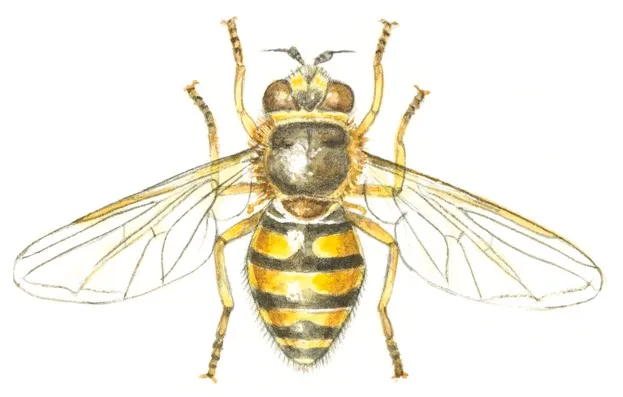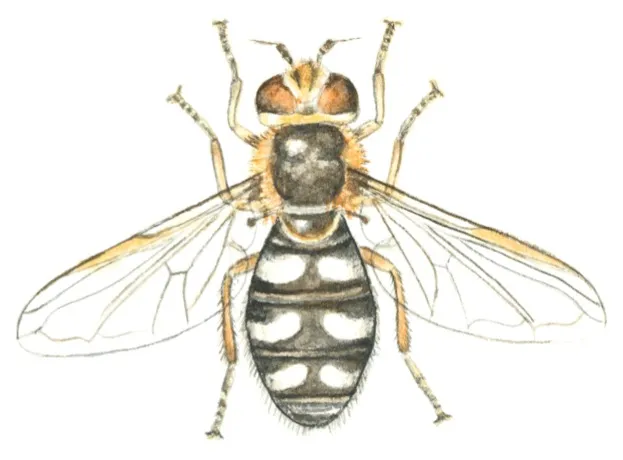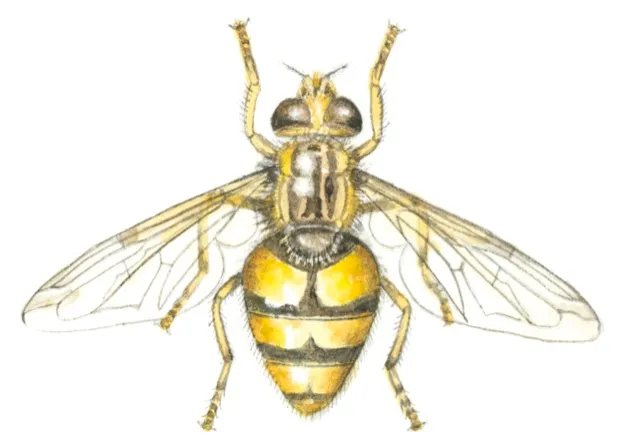Build up your garden list – even small plots can attract 20 or more species. Hoverfly numbers peak in late morning on warm, sunny days in July and August.
Many hoverflies are wasp or bee mimics. For example, some drone flies in the genus Eristalis look like honeybees, Volucella inanis resembles hornets and V. bombylans is a very convincing bumblebee mimic. Invasions of ‘wasps’ reported by the media often turn out to be banded hoverflies in the tribe Syrphini.
Hoverfly larvae have a huge range of lifestyles. Some species develop inside bee nests, while the grubs of Xanthogramma pedissequum inhabit yellow-ant nests. Drone-fly larvae, known as rat-tailed maggots, live in ponds, compost and rotting manure, breathing through long siphons.
Some hoverflies migrate long distances, much like butterflies such as red admirals. Episyrphus balteatus is resident throughout the UK but also travels here in large numbers from continental Europe. Scaeva pyrastri is another frequent cross-Channel migrant.
All illustrations by Felicity Rose Cole
Syrphus ribessi

One of three very similar yellow and black banded species. Produces the loud hum often heard in midsummer woods. Also seen in gardens and fields.
Xanthogramma pedissequum

Mimics wasps, with yellow triangles on first abdominal segment; dark wing marks. Grassland, mainly in south.
Marmalade hoverfly Episyrphus balteatus

Unique pattern of double black bars on each abdominal segment. Open countryside, woods and gardens.
Scaeva pyrastri

Large, with white 'comma' markings on black abdomen. Migrates from mainland Europe to UK gardens and open country; numbers vary annually.
Eristalis arbustorum

Medium-sized dronefly. Mimics honeybees; usually has bold orange triangles at base of abdomen. Open countryside, woods and gardens.
Tapered drone-fly Eristalis pertinax

Large drone-fly. Mimics honeybees. Yellow-tipped front and middle legs. Open country, woods and gardens.
Eristalis intricarius (male)

Furry bumblebee mimic. Sexes are unusually well differentiated: tail is white in male and reddish in female. Gardens and open countryside.
Helophilus pendulus

Yellow-striped thorax. Gardens, open country and woods. Breeds in ponds, compost and manure. H. Hybridus is a very similar wetland species.
Volucella inanis

Large. Mimics hornets; the similar V. zonaria is even larger and rustier. Gardens and woodland edge; mainly in south and Midlands but spreading.
Volucella bombylans

Furry and colourful, Volucella bombylans is an excellent bumblebee mimic. It has two main colour forms: one is black with a red tail, imitating the red-tailed bumblebee (Bombus lapidarius); the other has yellow patches and a white tail, like the white-tailed bumblebees (B. lucorum and B. hortorum). Its larvae scavenge debris and scraps in bumblebee nests and may also prey on the brood itself.
Great pied hoverfly Volucella pellucens

This hoverfly lays its eggs in wasps’ nests and has been seen to walk unhindered into the mouth of one to do so. It is a large and unmistakeable hoverfly, with broad white patches on fat, black abdomen. It is commonest in woodland glades and along hedgerows, where it hovers about three metres above the ground. From below, it is easy to identify by the broad white band on its abdomen, which appears translucent in the summer sunshine.
Xylota segnis

Mimics solitary wasps. Orange band on slim black abdomen; partly yellow legs. Leafy gardens, hedgerows and woods; scuttles over leaves and logs.
Main image: A marmalade hoverfly feeding on the pollen of a verbascum. © Rod Hill/Getty




